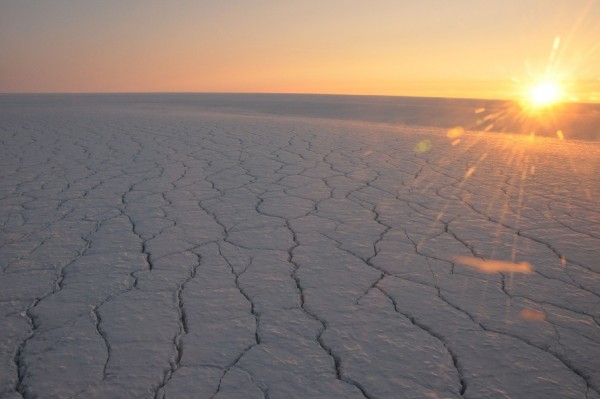By Ana Verayo, | April 15, 2016

Clouds over the Greenland ice sheet raise the temperature, which causes extra meltwater – a third more than clear skies.
A newly discovered region in Greenland near the Arctic Circle has been found to be rapidly melting earlier this year. Scientists reveal how this ice sheet has been melting faster than ever before, especially this spring, where ice thaws slightly when temperatures begin to rise before it freezes again come winter.
Like Us on Facebook
However, the earliest time when ice melted fast when spring came was during May 2010 where 10 percent of the sheet melted away. This year, this record was broken last April 11 where 12 percent of the Greenland ice sheet began to thaw, according to the Danish Meteorological Institute.
According climate scientist Peter Landgren from the DMI, he was first incredulous about the results of this year's thaw, which began so early this year than normally anticipated. He also says that the team had to check again the models if they were indeed working properly. Landgren also noted that the ice sheet has been above melting, above 10 degrees Celsius.
According to Robert Fausto from the Danish Geological Survey, most of the melting can be seen in the lower parts of Greenland since the higher parts of the ice sheet are farther from the ocean and colder than the other regions that experienced very high temperatures.
One temperature recording station located higher above sea level compared to the Ben Nevis peak, observed a maximum high of 3.1 Celsius. Fausto says even if this does not sound too hot, this is compared to a warm day in July.
According to DMI climate scientist Martin Stendel, this unusual early melt is driven by a combination of cold air and low pressures found emanating from the east and west regions of Greenland, causing a warm air "cap" over the island.
Experts are now expecting for temperatures to cool over again for the remainder of the month although more problems will stem from this, as water from this melted ice can run and seep into the snow and freeze again, that can heat up the ice underneath the surface. The previous fastest ice melt thaw record also happened just a month before where this event marks a surprising spike in temperatures in just a short span of time.
This new study is published in the journal, Geophysical Research Letters.
-
Use of Coronavirus Pandemic Drones Raises Privacy Concerns: Drones Spread Fear, Local Officials Say

-
Coronavirus Hampers The Delivery Of Lockheed Martin F-35 Stealth Fighters For 2020

-
Instagram Speeds Up Plans to Add Account Memorialization Feature Due to COVID-19 Deaths

-
NASA: Perseverance Plans to Bring 'Mars Rock' to Earth in 2031

-
600 Dead And 3,000 In The Hospital as Iranians Believed Drinking High-Concentrations of Alcohol Can Cure The Coronavirus

-
600 Dead And 3,000 In The Hospital as Iranians Believed Drinking High-Concentrations of Alcohol Can Cure The Coronavirus

-
COVID-19: Doctors, Nurses Use Virtual Reality to Learn New Skills in Treating Coronavirus Patients







